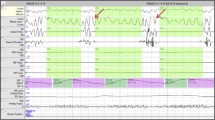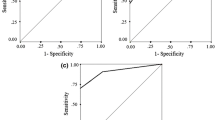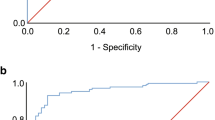Abstract
Obstructive sleep apnea syndrome (OSAS) is a major public health problem. The golden reference for diagnosing OSAS is the sleep-laboratory based polysomnography (PSG). However, screening of population for OSAS may be practical and cost efficient only through ambulatory home recordings. In this work we aimed to design, construct and evaluate a novel ambulatory device for these recordings. The device was designed to record breathing movements, nasal and oral flow, position, snore, blood oxygen saturation and heart rate. The first part of clinical evaluation was done by recording 19 patients simultaneously with the novel device and with clinical reference instrumentation at a sleep laboratory. In the simultaneous recordings, no statistically significant difference was detected in the apnea-hypopnea index. All patients were correctly diagnosed, as compared to the reference instrumentation, with the novel ambulatory device. The second part of clinical evaluation was conducted through 323 ambulatory home recordings of which 275 (193 males and 82 females) were of diagnostically acceptable quality. A total of 106 and 169 recordings were successfully conducted with the novel device and a commercial ambulatory device, respectively. Both devices showed similar diagnostic capability in detecting sleep apnea. The novel device was found clinically applicable, technically reliable and sensitive for the diagnostics of OSAS.



Similar content being viewed by others
References
Chesson AL Jr, Berry RB, Pack A (2003) Practice parameters for the use of portable monitoring devices in the investigation of suspected obstructive sleep apnea in adults. Sleep 26:907–913
Chesson AL Jr, Ferber RA, Fry JM et al (1997) The indications for polysomnography and related procedures. Sleep 20:423–487
Dingli K, Coleman EL, Vennelle M et al (2003) Evaluation of a portable device for diagnosing the sleep apnoea/hypopnoea syndrome. Eur Respir J 21:253–259. doi:10.1183/09031936.03.00298103
Ferber R, Millman R, Coppola M et al (1994) Portable recording in the assessment of obstructive sleep apnea: ASDA standards of practice. Sleep 17:378–392
Flemons WW, Littner MR, Rowley JA et al (2003) Home diagnosis of sleep apnea: a systematic review of the literature: an evidence review cosponsored by the American Academy of Sleep Medicine, the American College of Chest Physicians, and the American Thoracic Society. Chest 124:1543–1579. doi:10.1378/chest.124.4.1543
Fleury B, Rakotonanahary D, Hausser-Hauw C et al (1996) A laboratory validation study of the diagnostic mode of the Autoset system for sleep-related respiratory disorders. Sleep 19:502–505
Gagnadoux F, Pelletier-Fleury N, Philippe C et al (2002) Home unattended vs hospital telemonitored polysomnography in suspected obstructive sleep apnea syndrome: a randomized crossover trial. Chest 121:753–758. doi:10.1378/chest.121.3.753
Kemp B, Olivan J (2003) European data format ‘plus’ (EDF+), an EDF alike standard format for the exchange of physiological data. Clin Neurophysiol 114:1755–1761. doi:10.1016/S1388-2457(03)00123-8
Kulkas A, Rauhala E, Huupponen E et al (2008) Detection of compressed tracheal sound patterns with large amplitude variation during sleep. Med Biol Eng Comput 46:315–321. doi:10.1007/s11517-008-0317-z
Kushida CA, Littner MR, Morgenthaler T et al (2005) Practice parameters for the indications for polysomnography and related procedures: an update for 2005. Sleep 28:499–521
Lam JC, Ip MS (2007) An update on obstructive sleep apnea and the metabolic syndrome. Curr Opin Pulm Med 13:484–489. doi:10.1097/MCP.0b013e3282efae9c
Min SD, Yoon DJ, Yoon SW et al (2007) A study on a non-contacting respiration signal monitoring system using Doppler ultrasound. Med Biol Eng Comput 45:1113–1119. doi:10.1007/s11517-007-0246-2
Nyquist H (2002) Certain topics in telegraph transmission theory. Proc IEEE 90:280–305. doi:10.1109/5.989875
Penzel T, Kemp B, Klosch G et al (2001) Acquisition of biomedical signals databases. IEEE Eng Med Biol Mag 20:25–32. doi:10.1109/51.932721
Portier F, Portmann A, Czernichow P et al (2000) Evaluation of home versus laboratory polysomnography in the diagnosis of sleep apnea syndrome. Am J Respir Crit Care Med 162:814–818
Ross SD, Sheinhait IA, Harrison KJ et al (2000) Systematic review and meta-analysis of the literature regarding the diagnosis of sleep apnea. Sleep 23:519–532
Usher MJ, Keating DA (1996) Sensors and transducers. Macmillan Press, Houndmills
Whittle AT, Finch SP, Mortimore IL et al (1997) Use of home sleep studies for diagnosis of the sleep apnoea/hypopnoea syndrome. Thorax 52:1068–1073
Williams T (1996) EMC for product designers. Newnes, Oxford
Yamashiro SM (2007) Non-linear dynamics of human periodic breathing and implications for sleep apnea therapy. Med Biol Eng Comput 45:345–356. doi:10.1007/s11517-006-0153-y
Young T, Evans L, Finn L et al (1997) Estimation of the clinically diagnosed proportion of sleep apnea syndrome in middle-aged men and women. Sleep 20:705–706
Young T, Palta M, Dempsey J et al (1993) The occurrence of sleep-disordered breathing among middle-aged adults. N Engl J Med 328:1230–1235. doi:10.1056/NEJM199304293281704
Acknowledgments
The financial support from Foundation for Advanced Technology of Eastern Finland and Kuopio University Hospital is acknowledged. The technical support from Remote Analysis Ltd, Kuopio, Finland is acknowledged.
Author information
Authors and Affiliations
Corresponding author
Electronic supplementary material
Below is the link to the electronic supplementary material.
11517_2008_418_MOESM1_ESM.eps
The air pressure from the nasal prongs is brought to the pressure sensor chamber via a small plastics tube (a). The pressure is sensed by a piezo electric transducer and the signal is amplified and filtered before the analogue-to-digital converter. The changes in temperature due to inspiration and expiration are detected with three oro-nasal thermistors (b). The thermistors are biased and the signal is amplified and filtered before digitizing. Thorax and abdominal movements are detected with custom-made double strain gauges (c). The weak signals obtained from the strain gauges are strongly amplified and then band-pass filtered before analogue-to-digital conversion. Snoring sounds (air pressure levels) are detected with a DC biased electret microphone (d). Two operational amplifiers generate virtual grounds midway between a single power supply for the analog electronics (e). With custom made resistive (from zero to infinity) jumpers to connectors J1 – J3 the gains of the last amplifiers can be adjusted. (EPS 506 kb)
Rights and permissions
About this article
Cite this article
Tiihonen, P., Pääkkönen, A., Mervaala, E. et al. Design, construction and evaluation of an ambulatory device for screening of sleep apnea. Med Biol Eng Comput 47, 59–66 (2009). https://doi.org/10.1007/s11517-008-0418-8
Received:
Accepted:
Published:
Issue Date:
DOI: https://doi.org/10.1007/s11517-008-0418-8




